Table of Contents
Class 9 Extra Questions Very Short Answer Questions
Question 1. List two conditions which need to be satisfied for the work to be done on an object.
Answer: W = Fs
Work is done when
(a) a force acts on an object
(b) object is displaced.
Also Check: CBSE Syllabus for Class 9
Question 2. Explain the following terms with one example each:
(a) Positive work
(b) Zero work
Answer: (a) When force acts in the direction of motion of body work done is positive. When a lawn roller is pulled forward, work done is positive.
(b) When force is perpendicular to the direction of motion, work done is zero. A porter carrying load does no work.
Question 3. From where do we get energy for the life processes?
Answer: The energy required for the various life processes comes from the food that we eat.
Question 4. A girl is running along a circular path with a uniform speed. How much work is done by the girl?
Answer: Zero.
Question 5. Moment of force and work done by a force have the same units. Then, what is the difference between them?
Answer: Moment of a force produces rotatory motion in a body whereas when a force does work on a body it produces translatory motion in it.
Question 6. A coolie is walking on a railway platform with a load of 27 kg on his head. What is the amount of work done by him?
Answer: Work done by the coolie is zero, as W = Fs cos 90° = 0.
Question 7. What is the amount of work done by a man in pressing a rigid wall with a force of 400 N?
Answer: Zero because there is no displacement.
Also Check: CBSE Syllabus for Class 9
Question 8. Which law was verified experimentally by James Prescott Joule?
Answer: Law of conservation of energy.
Question 9. State the law of conservation of energy.
Answer: The law of conservation of energy states that energy can neither be created nor destroyed, it can only be transformed from one form to another.
Question 10. Name the two common forms of mechanical energy.
Answer: Kinetic energy and potential energy.
Question 11. By what factor does the kinetic energy of a body increase when its speed is doubled?
Answer: By a factor of 4 ( KE ∝ v2).
Question 12. What is negative work.
Answer: Work done against friction is a negative work.
Question 13. Out of a light and a heavy body having equal kinetic energy, which one will is move fast?
Answer: The lighter body because v = \(\sqrt{\frac{2 K E}{m}}\)
Question 14. What type of energy is stored in the spring of a watch?
Answer: Elastic potential energy.
Also Check: NCERT Solutions for Class 9 Maths
Question 15. When an arrow is shot from its bow, it has kinetic energy. From where does it get this kinetic energy?
Answer: A stretched bow possesses potential energy on account of a change in its shape. When the arrow is released, the potential energy of the bow gets converted into the kinetic energy of the arrow.
Question 16. Can kinetic energy of a body be negative?
Answer: No, because both m and v2 are always positive.
Question 17. An electric cell converts which form of energy into which other form?
Answer: Chemical energy gets converted into electrical energy.
Question 18. Which instrument transforms electrical energy into mechanical energy?
Answer: Electric motor.
Question 19.
When an electric bulb is switched on, what energy transformation takes place?
Answer:
Electric energy changes into light energy and heat energy.
Question 20.
What kind of energy transformation takes place at thermal power station?
Answer:
Heat energy is converted into electrical energy.
Also Check: NCERT Solutions for Class 9 Science
Question 21.
A car is accelerated on a levelled road and attains a velocity four times its initial velocity. In this process, how does the potential energy of the car change?
Answer:
Potential energy (= mgh) does not change as it does not depend on velocity.
Question 22.
What is the angle between the force and displacement in the case of negative work?
Answer:
180°.
Question 23.
A student picks up four books from the floor, walks across the room through some distance with the books at the same height and then keeps these books at the new place. In which of these sequence of actions work is said to be performed ?
Answer:
When the student is picking up books from the floor in the beginning.
Work, Power And Energy Class 9 Extra Questions Short Answer Questions-I
Question 1.
Give two examples from everyday life where work is done.
Answer:
- We apply a force to lift a book at a height and the book rises.
- When a bullock pulls a cart, it moves as work is done by the bullock on the cart.
Question 2.
On what factors the work done on a body depends?
Answer:
The work done on a body depends upon two factors:
- Magnitude of the force (F), and
- The displacement through which the body moves (s).
Also Check: Extra Questions for Class 9 Maths with Solutions
Question 3. What is energy? What is unit of energy?
Answer:
The capacity of a body to do work is called energy possessed by the body. It is a scalar quantity and is measured in joule (J).
Generally, for practical purposes, a bigger unit called kilojoule (kj) is used (1 kj = 1000 J).
Question 4.
Give any two uses of kinetic energy.
Answer:
- The kinetic energy of air is used to run windmills.
- The kinetic energy of the running water is used to generate electricity.
Question 5.
Give one example each of potential energy
(i) due to position
(ii) due to shape.
Answer:
(i) Potential energy due to position: Water stored in dam has potential energy.
(ii) Potential energy due to shape: In a toy car, the wound spring possesses potential energy, and as the spring is released, its potential energy changes into kinetic energy due to which the car moves.
Question 6.
(a) What kind of energy transformation takes place when a body is dropped from a certain height?
Answer:
When a body falls, its potential energy gradually gets converted into kinetic energy. On reaching the ground, the whole of the potential energy of the body gets converted into kinetic energy.
(b) What is the commercial unit of energy?
Answer:
The commercial unit of energy is kilowatt hour [kWh].
1 kWh is the energy used in one hour at the rate of 1000 Js-1.
Also Check: Forest Society and Colonialism Class 9 Notes History
Question 7.
What is the relationship between the commercial unit and SI unit of energy?
Answer:
We know that,
lkWh = 1 kW × 1 h
= 1000 W × 3600 s
= 1000 Js-1 × 3600 s
= 3600000 J
∴ l kWh = 3.6 × 106J
Question 8.
Calculate the work done against the gravity.
Answer:
Suppose a body of mass m is lifted vertically upwards through a distance h. In this case, the force required to lift the body will be equal to weight of the body, mg (where m is mass and g is acceleration due to gravity). Now,
Work done in lifting a body = Weight of body × Vertical distance
W = mg × h
= mgh
Where W = Work done, and h = Height through which the body is lifted.
Question 9.
What is power? How do you differentiate kilowatt from kilowatt hour? [NCERT Exemplar]
Answer:
Power is the rate of doing work. Kilowatt is the unit of power and kilowatt hour is the unit of energy.
Question 10.
Observe the diagrams I and II carefully. An object of mass m is lifted from A to B to height h along path 1 and path 2. What would be the work done on the object in both the cases? Give reasons for your answer.
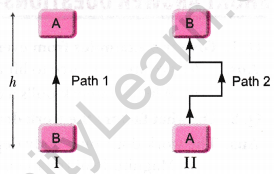
Answer:
Work done in diagram I = mgh. Work done in diagram II = mgh. Work done by gravity depends on the differences in vertical heights of the initial and final positions of the object and not on the path along which the object is moved.
Extra Questions Short Answer Questions-II
Question 1.
Give three examples when the object is not displaced in spite of a force acting on it.
Answer:
Three examples when force being supplied and still there is no displacement are:
- A man pushing a stationary truck.
- A man pushing a rigid wall.
- A boy carrying a basket on his head and standing still. Here, force of gravity acts on the basket, but there is no displacement.
Question 2.
What types of energy transformation takes place in the following:
(i) Electric heater
(ii) Solar battery
(iii) Dynamo
(iv) Steam engine and
(v) Hydroelectric power station?
Answer:
(i) Electric heater: Electric energy into heat energy.
(ii) Solar battery: Solar energy into electric energy.
(iii) Dynamo: Mechanical energy into electric energy.
(iv) Steam engine: Heat energy to mechanical energy.
(v) Hydroelectric power station: Mechanical energy into electric energy.
Question 3.
(a) Derive an expression for kinetic energy of an object.
(b) If the velocity of an object is doubled. What will be change in its kinetic energy?
Answer:
Suppose a body of mass m is moving with velocity v. It is brought to rest by applying a retarding force F. Suppose it traverses a distance s before coming to rest.
Kinetic energy of body, KE = Work done by retarding force to stop it.
i.e., Kinetic energy = F. s …(i) .
But Retarding force, F = ma …(ii)
Initial velocity = v, final velocity = 0
From the equation, v2 = u2 + 2as, we have
0 = v2 – 2as (because here a is retardation)
⇒ Distance = s = \(\frac{v^{2}}{2 a}\) ………(iii)
Substituting values of F and s from (ii) and (iii) in (i), we get
Kinetic energy, KE = ma × \(\frac{v^{2}}{2 a}=\frac{1}{2}\) mv2
Question 4.
A rocket is moving up with a velocity v. If the velocity of this rocket is suddenly tripled, what will be the ratio of two kinetic energies? [NCERT Exemplar]
Answer:
Initial velocity = v, then final velocity, v’ = 3v
Initial kinetic energy = \(\frac{1}{2}\)mv2
Final kinetic energy (KE) = \(\frac{1}{2}\) mv’2 = \(\frac{1}{2}\) m(3v)2 = 9\(\left(\frac{1}{2} m v^{2}\right)\)
(KE)initial : (KE )final = 1 : 9.
Question 5.
Avinash can run at a speed of 8 ms-1 against the frictional force of 10 N, and Kapil can move at a speed of 3 ms-1 against the frictional force of 25 N. Who is more powerful and why? [NCERT Exemplar]
Answer:
Power of Avinash PA = FA . vA = 10 × 8 = 80 W
Power of Kapil Pk = Fk . vk = 25 × 3 = 75 W
So, Avinash is more powerful than Kapil.
Question 6.
The velocity of a body moving in a straight line is increased by applying a constant force F, for some distance in the direction of the motion. Prove that the increase in the kinetic energy of the body is equal to the work done by the force on the body. [NCERT Exemplar]
Answer:
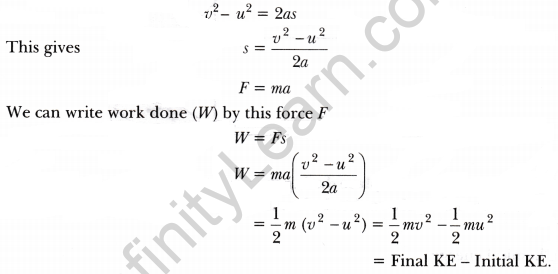
Question 7.
(a) Give one example of each of the following:
- Small mass but high kinetic energy
- Large mass but low kinetic energy
(b) Prove mathematically that the total mechanical energy of a freely falling body in air is conserved.
Answer:
(a)
- A cricket/hockey ball which has been hit hard and is travelling fast.
- A shot put thrown by an athlete
(b) Let the body of mass m at height h above the ground starting from rest, be falling freely.
Total energy of the body at height h
= mgh (PE) + 0 (KE) = mgh
After the body has fallen freely through a distance x (say),
KE = mgh, PE = mg (h – x)
Total energy = KE + PE
= mgh + mg (h – x) = mgh
When it reaches the ground KE = \(\frac{1}{2}\)m.2gh = mgh
PE = 0, Total Energy = KE + PE = mgh
Thus, the total mechanical energy, which is the sum of KE and PE is always equal to mgh.
Question 8.
Figure shows, in order, five stages of an athlete successfully performing a pole-vault.
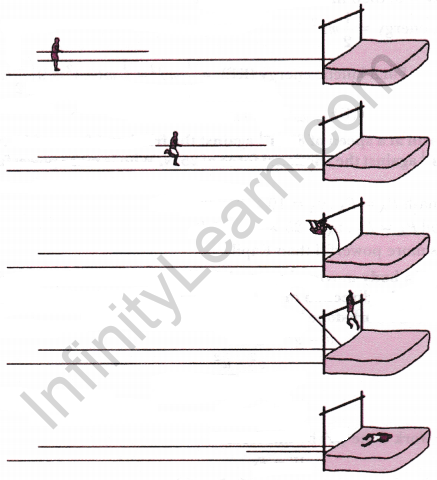
Describe the energy changes which take place during the performance of the pole-vault, from the original stationary position of the pole-vaulter before the run-up, to the final stationary position after the vault.
Answer:
Standing : Chemical energy
Run-up : Kinetic energy
Pole bent : Elastic energy
Rise : Potential energy gained
Fall : Kinetic energy gained
On mat : Heat or sound energy
Question 9.
Two workmen are employed on a building project, as shown in figure.
(i) Workman 1 drops a hammer, which falls to the ground. The hammer has a mass of 2.0 kg, and is dropped from a height of 4.8 m above the ground.
(a) Calculate the change in gravitational potential energy of the hammer when it is dropped.
(b) Describe the energy changes from the time the hammer leaves the hand of workman 1 until it is at rest on the ground.
(ii) Workman 2 picks up the hammer and takes it back, up the ladder to workman 1. He climbs the first 3.0 m in 5.0 s. His total weight, including the hammer, is 520 N.
Calculate the useful power which his legs are producing.
Answer:
(i) (a) Mass, m = 2.0 kg, height, h = 4.8 m
= mgh
= 2 × 10 × 4.8 = 96 J
(b) Potential energy → Kinetic energy → Heat and/or sound energy
(ii) Weight, mg = 520 N, height, h = 3.0 m, Time, t = 5.0 s
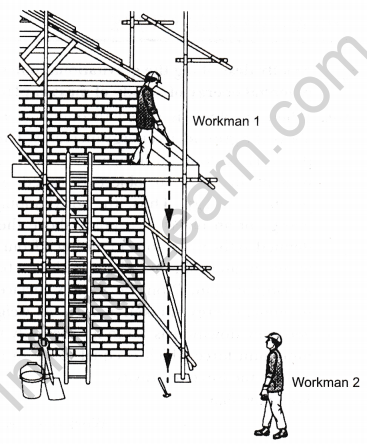
Question 10.
(a) A body thrown at a certain angle to the ground moves in a curved path and falls back to the ground. The initial and final points of the path of the object lie on the same horizontal line. What is the work done by the force of gravity on the object?
(b) You lift a heavily packed carton of mass m in vertically upward direction through a height h. What is the work done
- by you on the carton,
- by force of gravity on the carton?
(c) Anil is doing work at a rapid rate but works for only one hour. Ashok does work at a somewhat slower rate but continues to work for six hours. Who has greater power? Who has more energy?
Answer:
(a) Work done is zero. This is because equal and opposite work is done in the two paths.
(b)
- Work done by me is positive and having a value = mgh. This is because I am applying force in vertically upward direction on the carton to hold it and displacement is also in the same direction.
- Work done by the force of gravity on the carton= – mgh. This in because force is vertically – downward but motion is vertically upward.
(b) Anil has greater power because his rate of doing work is more. Ashok has more energy as he worked for a longer time and the total work done by him in definitely more.
Work, Power And Energy Class 9 Extra Questions Long Answer Questions
Question 1.
Briefly describing the gravitational potential energy, deduce an expression for the gravitational potential energy of a body of mass m placed at a height h, above the ground.
Answer:
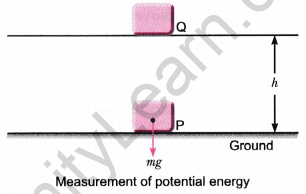
When an object is raised through a certain height above the ground, its energy increases. This is because the work is done on it, against gravity. The energy present in such an object is called gravitational potential energy. Thus, the gravitational potential energy of an object at a point above the ground is defined as the work done in raising it from the ground to that point against gravity. Consider a body of mass m lying at point P on the Earth’s surface, where its potential energy is taken as zero. As weight, mg acts vertically downwards, so to lift the body to another position Q at a height h, we have to apply a minimum force which is equal to mg in the upward direction. Thus, work is done on the body against the force of gravity.
We know that,
Work done, W = Fs …(i)
As F = mg and s = h
Putting these values in equation (i), we get
W = mg × h = mgh
This work done on the body is equal to the gain in energy of the body. This is the potential energy of the body.
∴ Potential energy PE = mgh
Question 2.
Show that when a body is dropped from a certain height, the sum of its kinetic energy at any instant during its fall is constant.
Answer:
The mechanical energy (kinetic energy + potential energy) of a freely falling object remains constant. It may be shown by calculation as follows:
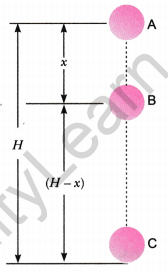
Suppose a body of mass m falls from point A, which is at height ‘H’ from the surface of earth. Initially at point A, kinetic energy is zero and the body has only potential energy.
Total energy of body at point A
= Kinetic energy + Potential energy
= 0 + mgH = mgH …(i)
Suppose during fall, the body is at position B. The body has fallen at a distance x from its initial position. If velocity of body at B is v, then from formula v2 = u2 + 2as, we have
v2 = 0 + 2 gx = 2 gx
Kinetic energy of body at point B = \(\frac{1}{2}\) × mv2
= \(\frac{1}{2}\)m × 2gx = mgx
Potential energy of body at point B = mg (H – x)
∴ Total energy of body at point B = Kinectic energy + Potential energy
= mgx + mg(H – x) = mgx …(ii)
Now suppose the body is at point C, just above the surface of earth (i.e., just about to strike the earth). Its potential energy is zero.
The height by which the body falls = H
If v is velocity of body at C, then from formula
v2 = u2 + 2as
We have u=0, a = g, s = H
So, v2 = 0 + 2gH = 2gH
Kinetic energy of body at position C = \(\frac{1}{2}\)mv2
= \(\frac{1}{2}\) m × 2gH = mgH
∴ Total energy of body at C
= Kinetic energy + Potential energy
= mgH + 0 = mgH …(iii)
Thus, we see that the sum of kinetic energy and potential energy of freely falling body at each point remains constant.
Thus, under force of gravity, the total mechanical energy of body remains constant.
Question 3.
A light and a heavy object have the same momentum, find out the ratio of their kinetic energies.
Which one has a larger kinetic energy ? [NCERT Exemplar]
Answer:
Linear momentum of first object, p1 = m1v1 and of second object, p2 = m2v2
But, p1 = p2
or, m1v1 = m2v2
If m1 < m2 then v1 > v2

Therefore, (K.E.)1 > (K.E.)2
Question 4.
Four men lift a 250 kg box to a height of 1 m and hold it without raising or lowering it. (a) How much work is done by the men in lifting the box? (b) How much work do they do in just holding it? (c) Why do they get tired while holding it? (g = 10 ms-2) [NCERT Exemplar]
Answer:
(a) F = 250 kg × 10 ms-2 (g = 10 ms-2)
= 2500 N
s = 1 m
W = F.s
= 2500 N × 1 m
= 2500 Nm = 2500 J
(b) Zero, as the box does not move at all while holding it.
(c) In order to hold the box, men are applying a force which is opposite and equal to the gravitational force acting on the box. While applying the force, muscular effort is involved. So, they feel tired.
Question 5.
A car of mass 900 kg is travelling at a steady speed of 30 m/s against a resistive force of 2000 N, as illustrated in figure.

(i) Calculate the kinetic energy of the car.
(ii) Calculate the energy used in 1.0 s against the resistive force.
(iii) What is the minimum power that the car engine has to deliver to the wheels?
(iv) What form of energy is in the fuel,used by the engine to drive the car?
Answer:
(i) Kinetic energy = \(\frac{1}{2}\) mv2
= \(\frac{1}{2}\) × 900 × (30)2 = \(\frac{1}{2}\) × 900 × 900
= 4,05,000 J
(ii) Energy used = Work done against resistive force
= Force × Distance
= 20,000 × 30 = 60,000 J = 60 kJ
(iii) Minimum power = \(\frac{\text { Energy used }}{\text { Time taken }}\)
= \(\frac{60,000 \mathrm{J}}{1 \mathrm{s}}\) = 60,000 W = 60 kW
(iv) Chemical energy.
Question 6.
Figure shows a conveyor belt transporting a package to a raised platform. The belt is driven by a motor.

(i) State three types of energy, other than Motor-gravitational potential energy, into which the electrical energy supplied to the motor is converted.
(ii) The mass of the package is 36 kg. Calculate the increase in the gravitational potential energy (P.E.) of the package when it is raised through a vertical height of 2.4 m.
(iii) The package is raised through the vertical height of 2.4 m in 4.4 s. Calculate the power needed to raise the package.
(iv) Assume that the power available to raise package is constant. A package of mass greater than 36 kg is raised through the same height. Suggest and explain the effect of this increase in mass on the operation of the belt.
Answer:
(i) (a) Kinetic energy of belt or the package.
(b) Heat energy
(c) Sound energy
(ii) m = 36 kg, h = 2.4 m, g = 10 m/s2
Gravitational potential energy = mgh
= 36 × 10 × 2.4 = 864 J
(iii) Poer = \(\frac{\text { Work done }}{\text { Time taken }}=\frac{36 \times 10 \times 2.4}{4.4}=\frac{864}{4.4}=\frac{2160}{11}\) = 196.36 W
(iv) Mass is increased and power is constant, so increase in potential energy of mass is greater. Also, as mass is increased, speed is reduced and hence time taken is longer.
Numericals
Question 1.
A force of 20 N displaces a body through a distance of 1 m at an angle of 60° from its own direction. Calculate the amount of work done.
Solution:
Here, force F = 20 N, displacement, s = 1m.
Angle between force and displacement θ = 60°.
∴ Work done, W = Fs cos θ = 20 × 1 × cos 60°= 20 × 1 × \(\frac{1}{2}\) = 10 J.
Question 2.
Calculate the work done in lifting 200 kg of a mass through a vertical distance of 6 m. Assume g = 10 m/s2.
Solution:
Work in lifting the mass is done against gravity.
Therefore, the work done is W = mgh
We know, m = 200 kg, g = 10 m/s2 and h = 6 m .
W = mgh
= 200 × 10 × 6 = 12000J.
Question 3.
Find the velocity of a body of mass 100 g having a kinetic energy of 20 J.
Solution:
Here, mass of the body, m = 100 g = 0.1 kg
Kinetic energy, K.E. = 20 J = 20 Nm = 20 kg (m/s)2
Kinetic energy = \(\frac{1}{2}\) mv2

So, the velocity of the body is 20 m/s.
Question 4.
The speed of a vehicle of mass 500 kg increases from 36 km/h to 72 km/h. Calculate the increase in its kinetic energy.
Solution:
Given mass, m = 500 kg
The given unit of speed is km/h. It is to be converted into m/s.
1 km/h = \(\frac{1 \times 1000 \text { metre }}{3600 \text { second }}=\frac{5}{18} \mathrm{m} / \mathrm{s}\)
Initial speed, u = 36 km/h = 36 × \(\frac{5}{18}\) m/s = 10 m/s
Final speed, v = 72 km/h = 72 × \(\frac{5}{18}\) m/s = 20 m/s
∴ Gain in KE = Final KE – Initial KE
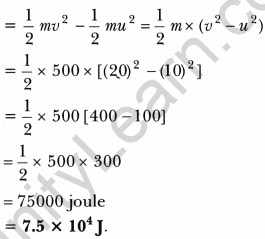
Question 5.
A man of mass 60 kg runs up a flight of 30 steps in 15 seconds. If each step is 20 cm high, calculate the power developed by the man. (Take g = 10 m/s2).
Solution:
Height of each step = 20 cm =0.20 cm
Height of 30 steps, H = 30 × 0.20 .
Time, t = 15 seconds
Force exerted by man against gravity
F = Weight of man = mg
∴ Work done by man = Force × Height = mg × H
Power, P = \(\frac{\text { Work }}{\text { Time }}=\frac{m g H}{t}\)
= \(\frac{60 \times 10 \times 6.0}{15}\) = 240 joule.
Question 6.
A machine raises a load of 750 N through a height of 16 m in 5 seconds. Calculate the power at which the machine works.
Solution:
Given force, F = 750 N, displacement = height, h = 16 m and time, t = 5
Work done by machine,
W = Force × Displacement = F × h
= 750 N × 16 joule
Power of machine, P = \(\frac{W}{t}=\frac{750 \mathrm{N} \times 16 \mathrm{J}}{5 \mathrm{s}}\) = 2400 watt.
Question 7.
If the power of a motor is 40 kW, at what speed can it raise a load of 20,000 N?
Solution:
Given power, P = 40 kW = 40 × 103 = 40,000 W
Force applied, F = Load = 20,000 N
If v is the speed of load, then we have
P = Fv
⇒ Speed, v = \(\frac{P}{F}=\frac{40,000}{20,000}\) = 2 m/s
Question 8.
An engine can pump 30,000 litres of water to a vertical height of 45 metres in 10 minutes. Calculate the work done by the machine and its power. [g = 9.8 m/s2; Density of water = 103 kg/m3, 1000 litre = 1 m3].
Solution:
Volume of water raised = 30,000 litres = \(\frac{30,000}{1000}\)m3 = 30 m3.
Mass of water raised, M = Volume × Density
= (30 m3) × (103 kg/m3)
= 30 × 103 kg
Height, h = 45 metre
Work done by machine,
W = Weight of water raised × Height
= (Mg) × h = (30 × 103 × 9.8) × 45
W= 1.323 × 107 joule.
Time taken, t = 10 minutes = 10 × 60= 600 seconds.
Power, P = \(\frac{W}{t}=\frac{1.323 \times 10^{7} \mathrm{J}}{600 \mathrm{s}}\)
= 22 × 103W
= 22 kW.
Question 9.
A boy is moving on a straight road against a friction force of 5 N. After travelling a distance of 1.5 km he forgot the correct path at a round about (Fig.) of radius 100 m. However, he moves on the circular path for one and half cycle and then he moves forward up to 2.0 km. Calculate the work done by him. [NCERT Exemplar]

Solution:
Force F = 5N; s = 1500 m + 2 × 100 m + 2000 m
Work done, W = F. s
W= 5 × [1500 + 200 + 2000]
= 18500 J.
Question 10.
The power of a motor pump is 2 kW. How much water per minute can the pump raise to a height of 10 m? (Given g =10 ms-2). [NCERT Exemplar]
Solution:
P = \(\frac{W}{\Delta t}=\frac{m g h}{\Delta t}\)
⇒ \(\frac{m \times 10 \times 10}{60}\) = 2000 W
or m = \(\frac{12000}{10}\)
= 1200 g.
Question 11.
If an electric iron of 1200 W is used for 30 minutes every day, find the electric energy consumed in the month of April. [NCERT Exemplar]
Solution:
Power, P = \(\frac{1200}{1000}\) = 1.2 kW
Time, t = \(\frac{30}{60}\) = 0.5 h
Electric energy, E = Power × time × days
= 1.2 × 0.5 × 30
= 18 kWh.
Question 12.
An automobile engine propels a 1,000 kg car A along a levelled road at a speed of 36 km h-1. Find the power if the opposing frictional force is 100 N. Now, suppose after travelling a distance of 200 m, this car collides with another stationary car B of same mass and comes to rest. Let its engine also stop at the same time. Now car B starts moving on the same level road without getting its engine started. Find the speed of the car B just after the collision. [NCERT Exemplar]
Solution:
mA = mB = 1000 kg. v= 36 km/h =10 m/s
Frictional force = 100 N
Since, the car A moves with a uniform speed, it means that the engine of car applies a force equal to the frictional force.
Power = \(\frac{\text { Force } \times \text { distance }}{\text { time }}\) = F.v
= 100N × 10m/s = 1000W
After collision,
mAuA + mBuB = mAvA + mBvB
1000 × 10 + 1000 × 0 = 1000 × 0 + 1000 × vB
vB = 10 ms-1.
Question 13.
A girl having a mass of 35 kg sits on a trolley of mass 5 kg. The trolley is given an initial velocity of 4 ms-1 by applying a force. The trolley comes to rest after traversing a distance of 16 m. (a) How much work is done on the trolley? (b) How much work is done by the girl? [NCERT Exemplar]
Solution:
u = 4 ms-1, v = 0,5 = 16 m
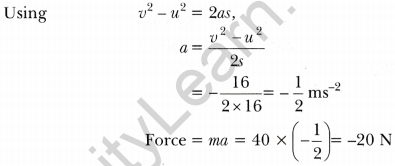
Work done on the trolley = 20N × 16m = 320 J.
Work done by the girl = 0 J.
Question 14.
The Jog falls in Karnataka state are nearly 20 m high 2,000 tonnes of water falls from it in a minute. Calculate the equivalent power if all this energy can be utilised, (g = 10 ms-2) [NCERT Exemplar]
Solution:
h = 20 m, and mass = 2000 × 103 kg = 2 × 106 kg
Power = \(\frac{m g h}{t}=\frac{2 \times 10^{6} \times 10 \times 20}{60} \mathrm{W}\)
= \(\frac{4}{6}\) × 107 W = 6.6 × 106 W.
Question 15.
How is the power related to the speed at which a body can be lifted? How many kilograms will a man working with the power of 100 W, be able to lift at constant speed of 1 ms-1 vertically? [NCERT Exemplar]
Solution:
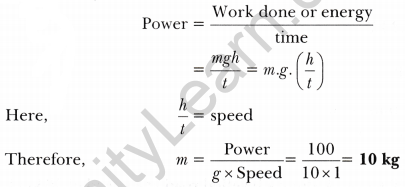
Question 16.
A 150 kg car engine develops 500 W for each kg. What force does it exert in moving the car at a speed of 20 ms-1? [NCERT Exemplar]
Solution:
1 kilowatt = 1000 J s-1
Total power = 150 × 5 00 = 7.5 × 104 W
Force = \(\frac{\text { Power }}{\text { Velocity }}\)
= \(\frac{7.5 \times 10^{4}}{20}\) = 3.75 × 103 N
Force = 3750 N.
Question 17.
Compare the power at which each of the following is moving upwards against the force of gravity, (given g = 10 ms-2). [NCERT Exemplar]
(i) A butterfly of mass 1.0 g that flies upward at a rate of 0.5 ms-1.
(ii) A 250 g squirrel climbing up a tree at a rate of 0.5 m s-1
Solution:
(i) Power = mg × velocity; g =10 ms-2
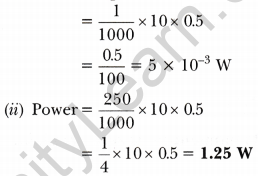
Hence, the power with which the squirrel is climbing is much higher than that of a flying butterfly.
Question 18.
The weight of a person on a planet A is about half of that on the Earth. He can jump up to 0.4 m high on the surface of the Earth. How high can he jump on planet A? [NCERT Exemplar]
Solution:
The potential energy of the person will remain the same on the Earth and on planet A.
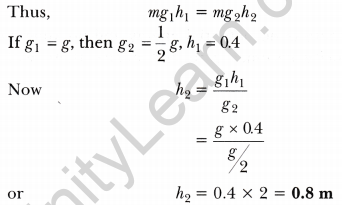
Question 19.
A ball is dropped from a height of 10 m. If the energy of the ball reduces by 40 per cent after striking the ground, how high can the ball bounce back? (g = 10 ms-2). [NCERT Exemplar]
Solution:
mgh = m × 10 × 10 = 100 m J.
If energy is reduced by 40%, then the remaining energy is 60 mJ.
Therefore, 60 m = m × 10 × h’
or h’ = 6 m
Question 20.
(a) Two masses in the ratio 1 : 4 have their speeds in the ratio 4 : 5. Find the ratio of their kinetic energy.
(b) The heart does 1.5 J of work in every beat. How many times per minute does it beat if its power is 2W?
Solution:
(a) Let m1 and m2 are masses of two bodies. Their velocities are v1 and v2 respectively.
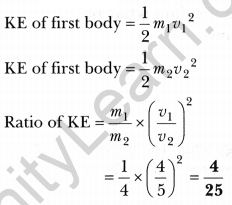
(b) Let number of heart beats per minute = n
Work done = 1.5 × n

Work, Power And Energy Class 9 Extra Questions HOTS (Higher Order Thinking Skills)
Question 1.
Can any object have mechanical energy even if its momentum is zero? Explain. [NCERT Exemplar]
Answer:
Yes, mechanical energy comprises of both potential energy and kinetic energy. Zero momentum means that velocity is zero. Hence, there is no kinetic energy but the object may possess potential energy.
Question 2.
Can any object have momentum even if its mechanical energy is zero? Explain. [NCERT Exemplar]
Answer:
No. Zero mechanical energy means that there is no potential energy and no kinetic energy. Therefore, if kinetic energy is zero, velocity becomes zero and hence, there will be no momentum.
Mathematically,
Mechanical energy = 0
⇒ PE = 0, KE = 0
⇒ v = 0
⇒ mv = p = 0
Question 3.
Is it possible that an object is in the state of accelerated motion due to external force acting on it, but no work is being done by the force? Explain with example. [NCERT Exemplar]
Answer:
Yes, it is possible, if an object is moving in a circular path because force is always acting perpendicular to the direction of displacement.
Question 4.
The diagram below shows a pendulum which was released from position A.
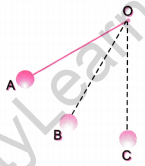
(a) What form(s) of energy did the pendulum have at
- A?
- B?
- C?
(b) Eventually the pendulum would stop moving. Explain what has happened to the initial energy of the pendulum.
Answer:
(a)
- Potential energy
- Potential energy + Kinetic energy
- Kinetic energy
(b) The initial energy is transformed into heat energy when the pendulum bob strikes the air molecules. Thus, the amplitude of pendulum decreases and finally it stops.






